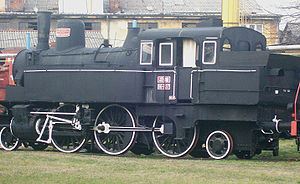- kkStB Class 229
-
SB Class 229 / kkStB Class 229 / EWA IIIa
BBÖ Class 229 / ČSD Class 354.0 / FS Class 912 / JDŽ Class 116 / PKP Class OKl12 / MÁV Class 343
ÖBB Class 75 / ČSD Class 354.05Number(s): kkStB 129.01–17
kkStB 229.01–239
kkStB 229.401–417
SB 229.01–11
EWA IIIa 41–50
BBÖ 229.04–239 (with gaps)
BBÖ 229.403–413 (with gaps)
BBÖ 229.501–511
BBÖ 229.801–810
ČSD 354.001–0145
FS 912.001–005
JDŽ 116-01–25
PKP OKl12-1–22
MÁV 343,301–315
ÖBB 75.701–764 (less 75.760)
ČSD 354.0501–0504, 0506Quantity: kkStB 129: 17
kkStB 229: 239
kkStB 229.4: 17 (rebuild from 129)
SB: 11
EWA: 10
BBÖ 229: 69 (ex-kkStB)
BBÖ 229.4: 5 (ex-kkStB)
BBÖ 229.5: 11 (ex-SB)
BBÖ 229.8: 10 (ex-EWA)
ČSD: 145 (ex-kkStB)
FS: 5 (ex-kkStB)
JDŽ: 25 (ex-kkStB)
PKP: 22 (ex-kkStB)
MÁV: 15 (ex-ČSD)
ÖBB: 63
ČSD 354.05: 5 (ex-BBÖ)Manufacturer: Wr. Neustadt, Floridsdorf, StEG, BMMF, Krauss/Linz Year(s) of manufacture: 1904–1918 Retired: ÖBB: 1962
ČSD: 1967Wheel arrangement: 2-6-2T Axle arrangement: 1'C1' n2vt Gauge: 1,435 mm Length: 11.766 mm Height: 4.568 mm Overall wheelbase: 8,000 mm Empty weight: 50.2 t Service weight: 67.1 t Adhesive weight: 38.0 t Top speed: 80 km/h Driving wheel diameter: 1,614 mm Leading wheel diameter: 870 mm Trailing wheel diameter: 870 mm No. of cylinders: 2 LP cylinder bore: 650 mm HP cylinder bore: 420 mm Piston stroke: 720 mm Boiler Overpressure: 14 bar No. of heating tubes: 200 Grate area: 2.00 m² Radiative heating area: 9.40 m² Tube heating area: 87.00 m² Water capacity: 9.8 m³ Fuel: 3.1 t coal The steam locomotive class kkStB 229 was a passenger tank engine class with the Imperial Austrian State Railways (k.k. österreichische Staatsbahnen), kkStB.
In order to improve local passenger services the kkStB procured 2-6-2 tank locomotives that were to replace the existing four-coupled tender locomotives in this role. One advantage of tank locomotives was that they did not need to be turned at the end of the route.
In their design Karl Gölsdorf laid particular emphasis on good acceleration. The 17 engines of this class, designated as the kkStB 129 were delivered by the Lokomotivfabrik Floridsdorf and Wiener Neustädter Lokomotivfabrik.
Because these Class 129 locomotives proved a total success, the Austrian Southern Railway or Südbahn wanted to procured similar engines, albeit with greater water and coal capacity. As a result Gölsdorf modified the design by adding a trailing axle. From 1903 to 1907 Floridsdorf supplied eleven units of this newly designated Class 229 to the Southern Railway, and from 1904 to 1918 the kkStB placed orders for a total of 239 units with all the Austrian locomotive factories. The Class 129 engines were rebuilt to 2-6-2s and placed into a new Class 229.4. In 1913 the Böhmisch-Mährische Maschinenfabrik delivered four 229s to the Serbian State Railway and the Wiener Neustädter Lokomotivfabrik built 10 units in 1909 and 1920 for the Aspangbahn (EWA, Eisenbahn Wien-Aspang), that were designated as the EWA IIIa Nos. 41–50.
After World War I 69 engines were left with the Austrian Federal Railways (then the BBÖ), to which were added the eleven engines of the Südbahn, grouped into Class 229.5, and ten machines of the EWA, grouped into Class 229.8, when these companies were nationalised. Other nations also ordered these locomotives giving them their own classifications. The Polish State Railways took delivery of 22 locomotives as PKP Class OKl12, the Yugoslavian Railways acquired 25 as JDŽ Class 116 and the Italian State Railways (FS) procured five as FS Class 912. But the bulk of the engines (145 units) went in 1918 to the Czechoslovak State Railways, who designated them as ČSD Class 354.0. As southern Slovakia was ceded in 1939 to Hungary, 15 units also went to the Hungarian State Railways () as the MÁV Class 343.3.
From 1926 to 1934 the ČSD rebuilt five of its 354.0 into superheated two-cylinder locomotives which they designated as the ČSD Class 355.0. These machines were also given a second steam dome and a connecting pipe between the domes. Between 1936 and 1940, the trailing axle on another five engines was replaced by a bogie; these locomotives then became the ČSD Class 353.1. In 1944 another engine was converted to superheating, but the second steam dome was not used.
After the Anschluss of Austria to the German Empire in 1938 the ninety 229s were classified by the Deutsche Reichsbahn asDRG Class 75.701–790. During the course of the war, the ČSD Class 355.0 was incorporated as DRG Class 75.901–905 into the DRB; likewise 21 PKP Class Okl12 locomotives as DRG Class 75.851–871 and nine JDŽ Class 116s as DRG Class 75.791–799.
After 1945, some 63 engines were grouped by the ÖBB into their ÖBB Class 75. The last of these machines were retired in 1962.
The former 229.137, 178, 187, 405 and 115 went into the ČSD as numbers 354.0501–0504 and 0506. The ČSD Class 354.0 was in service until 1967.
Several former 229s also went into the JDŽ and PKP.
Apart from normal use, at least 11 Polish locomotives were armoured in Poland and used in armoured trains during the Polish-Soviet War[1].
Literature
- Heribert Schröpfer, Triebfahrzeuge österreichischer Eisenbahnen - Dampflokomotiven BBÖ und ÖBB, alba, Düsseldorf, 1989, ISBN 3-87094-110-3
- Dieter Zoubek, Erhaltene Dampflokomotiven in und aus Österreich, Eigenverlag, 2004, ISBN 3-200-00174-7
- ^ Michał Derela, Locomotives of Polish armoured trains 1918-1930
See also
External links
- There is a relevant English-language forum at Railways of Germany
Categories:- Imperial Austrian State Railways steam locomotives
- 2-6-2T locomotives
- Floridsdorf locomotives
Wikimedia Foundation. 2010.

